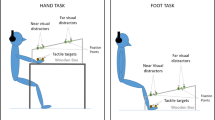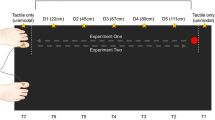Abstract
Interaction with objects in the environment typically requires integrating information concerning the object location with the position and size of body parts. The former information is coded in a multisensory representation of the space around the body, a representation of peripersonal space (PPS), whereas the latter is enabled by an online, constantly updated, action-orientated multisensory representation of the body (BR). Using a tool to act upon relatively distant objects extends PPS representation. This effect has been interpreted as indicating that tools can be incorporated into BR. However, empirical data showing that tool-use simultaneously affects PPS representation and BR are lacking. To study this issue, we assessed the extent of PPS representation by means of an audio-tactile interaction task and BR by means of a tactile distance perception task and a body-landmarks localisation task, before and after using a 1-m-long tool to reach far objects. Tool-use extended the representation of PPS along the tool axis and concurrently shaped BR; after tool-use, subjects perceived their forearm narrower and longer compared to before tool-use, a shape more similar to the one of the tool. Tool-use was necessary to induce these effects, since a pointing task did not affect PPS and BR. These results show that a brief training with a tool induces plastic changes both to the perceived dimensions of the body part acting upon the tool and to the space around it, suggesting a strong overlap between peripersonal space and body representation.






Similar content being viewed by others
References
Bassolino M, Serino A, Ubaldi S, Làdavas E (2010) Everyday use of the computer mouse extends peripersonal space representation. Neuropsychologia 48(3):803–811
Berlucchi G, Aglioti S (1997) The body in the brain: neural bases of corporeal awareness. Trends Neurosci 20(12):560–564
Blanke O (2012) Multisensory brain mechanisms of bodily self-consciousness. Nat Neurosci Rev 13:556–571
Bremmer F, Schlack A, Shah NJ, Zafiris O, Kubischik M, Hoffmann KP et al (2001) Polymodal motion processing in posterior parietal and premotor cortex: a human fMRI study strongly implies equivalencies between humans and monkeys. Neuron 29:287–296
Brozzoli C, Pavani F, Urquizar C, Cardinali L, Farnè A (2009) Grasping actions remap peripersonal space. NeuroReport 20(10):913–917
Canzoneri E, Magosso E, Serino A (2012) Dynamic sounds capture the boundaries of peripersonal space representation in humans. PLoS One 7:e44306
Cardinali L, Frassinetti F, Brozzoli C, Urquizar C, Roy AC, Farnè A (2009a) Tool-use induces morphological updating of the body schema. Curr Biol 19(12):R478–R479
Cardinali L, Brozzoli C, Farnè A (2009b) Peripersonal space and body schema: two labels for the same concept? Brain Topogr 21(3–4):252–260
Cardinali L, Brozzoli C, Urquizar C, Salemme R, Roy AC, Farnè A (2011) When action is not enough: tool-use reveals tactile-dependent access to Body Schema. Neuropsychologia 49:3750–3757
Carruthers G (2008) Types of body representation and the sense of embodiment. Conscious Cogn 17(4):1302–1316
Colby CL, Duhamel JR, Goldberg ME (1993) Ventral intraparietal area of the macaque: anatomic location and visual response properties. J Neurophysiol 69(3):902–914
Critchley M (1979) Corporeal awareness: body image; body scheme. In: Critchley M (ed) The divine banquet of the brain. Raven Press, New York, pp 92–105
de Vignemont F (2010) Body schema and body image: pros and cons. Neuropsychologia 48(3):669–680
de Vignemont F, Farnè A (2010) Incorporer des objets et des membres factices: quelle différence? Revue de Neuropsychologie 2:203–211
de Vignemont F, Ehrsson HH, Haggard P (2005) Bodily illusions modulate tactile perception. Curr Biol 15(14):1286–1290
Dijkerman HC, de Haan EH (2007) Somatosensory processes subserving perception and action. Behav Brain Sci 30(2):189–201; discussion 201–239
Duhamel JR, Colby CL, Goldberg ME (1998) Ventral intraparietal area of the macaque: congruent visual and somatic response properties. J Neurophysiol 79(1):126–136
Ebbinghaus H (1987) Memory: a contribution to experimental psychology. Dover Publications, New York
Farnè A, Làdavas E (2000) Dynamic size-change of hand peripersonal space following tool-use. NeuroReport 11(8):1645–1649
Farnè A, Làdavas E (2002) Auditory peripersonal space in humans. J Cogn Neurosci 14(7):1030–1043
Farnè A, Iriki A, Làdavas E (2005) Shaping multisensory action-space with tools: evidence from patients with cross-modal extinction. Neuropsychologia 43(2):238–248
Filimon F, Nelson JD, Huang RS, Sereno MI (2009) Multiple parietal reach regions in humans: cortical representations for visual and proprioceptive feedback during on-line reaching. J Neurosci 29(9):2961–2971
Fogassi L, Gallese V, Fadiga L, Luppino G, Matelli M, Rizzolatti G (1996) Coding of peripersonal space in inferior premotor cortex (area F4). J Neurophysiol 76(1):141–157
Gallagher S (1986) Body Image and Body Schema: a conceptual clarification. J Mind Behav 7:541–554
Gallagher S (2005) How the body shapes the mind. Oxford University Press, New York
Gallese V, Sinigaglia C (2010) The bodily self as power for action. Neuropsychologia 48(3):746–755
Graziano MS, Cooke DF (2006) Parieto-frontal interactions, personal space, and defensive behavior. Neuropsychologia 44(13):2621–2635
Graziano MS, Yap GS, Gross CG (1994) Coding of visual space by premotor neurons. Science 266(5187):1054–1057
Graziano MS, Hu XT, Gross CG (1997) Visuospatial properties of ventral premotor cortex. J Neurophysiol 77(5):2268–2292
Graziano MS, Reiss LA, Gross CG (1999) A neuronal representation of the location of nearby sounds. Nature 397(6718):428–430
Graziano MS, Cooke DF, Taylor CS (2000) Coding the location of the arm by sight. Science 290(5497):1782–1786
Head H, Holmes G (1911) Sensory disturbances from cerebral lesions. Brain 34(2–3):102
Holmes NP (2012) Does tool use extend peripersonal space? A review and re-analysis. Exp Brain Res 218(2):273–282
Holmes NP, Spence C (2006) Beyond the Body Schema: visual, prosthetic, and technological contributions to bodily perception and awareness. In: Knoblich G, Shiffrar M, Grosjean M (eds) The human body: perception from the inside out. Oxford University Press, New York
Holmes NP, Calvert GA, Spence C (2004) Extending or projecting peripersonal space with tools? Multisensory interactions highlight only the distal and proximal ends of tools. Neurosci Lett 372(1–2):62–67
Holmes NP, Sanabria D, Calvert GA, Spence C (2007) Tool-use: capturing multisensory spatial attention or extending multisensory peripersonal space? Cortex 43(3):469–489
Iriki A, Tanaka M, Iwamura Y (1996) Coding of modified body schema during tool-use by macaque postcentral neurones. NeuroReport 7(14):2325–2330
Kammers MP, de Vignemont F, Verhagen L, Dijkerman HC (2009) The rubber hand illusion in action. Neuropsychologia 47(1):204–211
Kammers MP, Mulder J, de Vignemont F, Dijkerman HC (2010) The weight of representing the body: addressing the potentially indefinite number of body representations in healthy individuals. Exp Brain Res 204(3):333–342
Làdavas E, Serino A (2008) Action-dependent plasticity in peripersonal space representations. Cogn Neuropsych 25(7–8):1099–1113
Làdavas E, di Pellegrino G, Farnè A, Zeloni G (1998) Neuropsychological evidence of an integrated visuotactile representation of peripersonal space in humans. J Cogn Neurosci 10(5):581–589
Linkenauger SA, Ramenzoni V, Proffitt, DR (2010) Illusory shrinkage and growth: body-based rescaling affects the perception of size. Psychol Sci 21(9):1318–1325
Linkenauger SA, Witt J, Proffitt DR (2011) Taking a hands-on approach: apparent grasping ability scales the perception of object size. J Exp Psychol Hum Percept Perform 37(5):1432–1441
Longo MR, Haggard P (2010) An implicit body representation underlying human position sense. Proc Natl Acad Sci USA 107(26):11727–11732
Longo MR, Haggard P (2011) Weber’s illusion and body shape: anisotropy of tactile size perception on the hand. J Exp Psychol Hum Percept Perform 37(3):720–726
Longo MR, Lourenco SF (2007) Space perception and body morphology: extent of near space scales with arm length. Exp Brain Res 177(2):285–290
Longo MR, Azañón E, Haggard P (2010) More than skin deep: body representation beyond primary somatosensory cortex. Neuropsychologia 48(3):655–668
Lopez C, Schreyer HM, Preuss N, Mast FW (2012) Vestibular stimulation modifies the body schema. Neuropsychologia 50(8):1830–1837
Magosso E, Ursino M, di Pellegrino G, Làdavas E, Serino A (2010) Neural bases of peri-hand space plasticity through tool-use: insights from a combined computational–experimental approach. Neuropsychologia 48(3):812–830
Makin TR, Holmes NP, Zohary E (2007) Is that near my hand? Multisensory representation of peripersonal space in human intraparietal sulcus. J Neurosci 27(4):731–740
Maravita A (2006) From body in the brain, to body in space: sensory and motor aspects of body representation. In: Knoblich G, Shiffrar M, Grosjean M (eds) The human body: perception from the inside out. Oxford University Press, New York
Maravita A, Iriki A (2004) Tools for the body (schema). Trends Cogn Sci 8(2):79–86
Maravita A, Husain M, Clarke K, Driver J (2001) Reaching with a tool extends visual-tactile interactions into far space: evidence from cross-modal extinction. Neuropsychologia 39(6):580–585
Maravita A, Spence C, Kennett S, Driver J (2002) Tool-use changes multimodal spatial interactions between vision and touch in normal humans. Cognition 83(2):B25–B34
Maravita A, Spence C, Driver J (2003) Multisensory integration and the body schema: close to hand and within reach. Curr Biol 13(13):R531–R539
Medina J, Coslett HB (2010) From maps to form to space: touch and the body schema. Neuropsychologia 48(3):645–654
Rizzolatti G, Scandolara C, Matelli M, Gentilucci M (1981) Afferent properties of periarcuate neurons in macaque monkeys. II. Visual responses. Behav Brain Res 2(2):147–163
Rizzolatti G, Fadiga L, Fogassi L, Gallese V (1997) The space around us. Science 277(5323):190–191
Schlack A, Sterbing-D’Angelo SJ, Hartung K, Hoffmann KP, Bremmer F (2005) Multisensory space representations in the macaque ventral intraparietal area. J Neurosci 25(18):4616–4625
Schwoebel J, Coslett HB (2005) Evidence for multiple, distinct representations of the human body. J Cogn Neurosci 17(4):543–553
Sereno MI, Huang RS (2006) A human parietal face area contains aligned head-centered visual and tactile maps. Nat Neurosci 9(10):1337–1343
Serino A, Haggard P (2010) Touch and the body. Neurosci Biobehav Rev 34(2):224–236
Serino A, Bassolino M, Farnè A, Làdavas E (2007) Extended multisensory space in blind cane users. Psychol Sci 18(7):642–648
Serino A, Canzoneri E, Avenanti A (2011) Fronto-parietal areas necessary for a multisensory representation of peripersonal space in humans: an rTMS study. J Cogn Neurosci 23(10):2956–2967
Sirigu A, Grafman J, Bressler K, Sunderland T (1991) Multiple representations contribute to body knowledge processing. Evidence from a case of autotopagnosia. Brain 114(Pt 1B):629–642
Sposito A, Bolognini N, Vallar G, Maravita A (2012) Extension of perceived arm length following tool-use: clues to plasticity of body metrics. Neuropsychologia 50(9):2187–2194
Stein BE, Meredith MA (1993) Merging of senses. MIT Press, Cambridge
Tajadura-Jiménez A, Väljamäe A, Toshima I, Kimura T, Tsakiris M, Kitagawa N (2012) Action sounds recalibrate perceived tactile distance. Curr Biol 22(13):R516–R517
Taylor-Clarke M, Jacobsen P, Haggard P (2004) Keeping the world a constant size: object constancy in human touch. Nat Neurosci 7(3):219–220
Todd J (1955) The syndrome of Alice in Wonderland. Can Med Ass J 73(9):701–704
van der Hoort B, Guterstam A, Ehrsson HH (2011) Being Barbie: the size of one’s own body determines the perceived size of the world. PLoS One 6(5):e20195
Yau JM, Olenczak JB, Dammann JF, Bensmaia SJ (2009) Temporal frequency channels are linked across audition and touch. Curr Biol 19:561–566
Acknowledgments
This work was supported by a Volkswagen Stiftung grant (the_unboundbody_project, ref. 85 639) to AS. The authors thank Patrick Haggard and Nicola Bruno for useful comments on data analysis and interpretation, Valentina Tedeschi and Marilena Marzolla for her help in data collection, Laura Taverna (Robotics, Brain and Cognitive Sciences, Istituto Italiano di Tecnologia) for photos of the experimental procedure and Adrian T. Smith for proof-reading and comments.
Author information
Authors and Affiliations
Corresponding authors
Rights and permissions
About this article
Cite this article
Canzoneri, E., Ubaldi, S., Rastelli, V. et al. Tool-use reshapes the boundaries of body and peripersonal space representations. Exp Brain Res 228, 25–42 (2013). https://doi.org/10.1007/s00221-013-3532-2
Received:
Accepted:
Published:
Issue Date:
DOI: https://doi.org/10.1007/s00221-013-3532-2




